table of contents
- What is an adult ceremony? - The age to be treated as a responsible adult is 20 years old. "Adult ceremony" is an event to encourage and bless them
- The origin of the adult ceremony - For boys, “original clothes” and for girls, “hair-lifting”
- Former clothes - What is “former clothes” performed when a boy is about 13 years old?
- Adult dress - In the adult ceremony, wear appropriate clothing for the milestones when you realize that you are an adult
- What is kimono - The kimono is gorgeous and is an indispensable item for the adult ceremony
- Adult gifts - Celebrate your family and give a memorable gift
What is an adult ceremony?
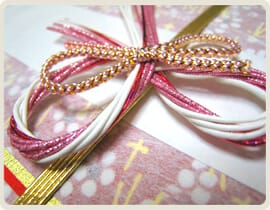 For ceremonial relationships, adult celebrations are not required.
For ceremonial relationships, adult celebrations are not required.The adult celebration is a celebration of the relatives, so it is basic to celebrate with parents and grandparents.
Generally, the gift is given until the day before the ceremony or in the morning.
You can also give a gift saying "It's an adult celebration" on your 20 birthday.
The approximate amount of money is between 5 1,000 yen and 1 10,000 yen for relatives, and about 3 1,000 yen for acquaintances.
It would be better to use a red-and-white bow and a table with "Adults", "Adults" and "Celebrations".
As gifts, suits, ties, watches, accessories, bags, etc. are generally useful after becoming a member of society,
If you are close relatives, you may be given cash.
In general, there ’s no need to give back to the adult-style celebration,
Please send a thank you note. Of course, after getting a celebration, it is good manners to be issued immediately.
And, of course, thank you letter of appreciation, and the person who celebrates it will do it by hand.
If you are not from relatives or relatives, it is common to return 1 / 3 from the amount you received.
► to top
The origin of the adult ceremony
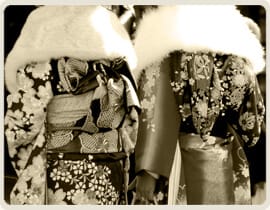 The ritual of celebrating adults has been around for a long time, and it is said that “formal clothes”, which were performed when boys were around the age of 13, are the origin of the present adult ceremony.
The ritual of celebrating adults has been around for a long time, and it is said that “formal clothes”, which were performed when boys were around the age of 13, are the origin of the present adult ceremony.As used in the meaning of "former clothes" being the head and "clothes", "former clothes" is an adult ceremony for boys who tie their hair for the first time,
Although it was considered a ritual for public houses and samurai families, it has spread to the private sector since the Muromachi period.
The ceremonial ceremony for getting a crown for the first time after being dressed is called “the crowning ceremony” and is the origin of the “crown” at the ceremonial occasion.
On the other hand, girls are called “hair-lifting rituals” and when they reach the age of 12 to 14 / 15, they tie their hair that they had been sorting out until then.
The rituals that drew behind and turned into hairstyles for adults, and the “ceremonial ceremonies” that wrinkle an adult woman's formal dress, pointed to the adult ceremonies.
It was derived from an old Chinese book that 20 was designated as an adult. In China, a boy 20 was said to be weak in the past, and he celebrated adults with a former dress and crown.
This is where the word “weak crown” for youth comes from.
The adult ceremonies held in local autonomy units like the current one are 1946 year 11 month 22 day,
It was carried out in Sakai-cho, Kitadachi-gun, Saitama Prefecture (currently Sakai City) to give young people a bright hope
It is said that the “adult ceremony” was started. In Showa 23, "Adult Day" is set on the 1 month 15 day of the New Year,
From 2000, it was established on the 1 Monday of the 2 month with the introduction of Happy Monday.
Considering new adults who leave home and go on to higher education or find employment, Golden Week, Obon,
There are also local governments that run on the 3rd day of the New Year.
► to top
Former clothes
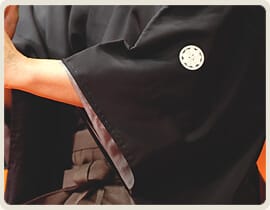 This is a ritual that has been held since the Nara period to show male adults.
This is a ritual that has been held since the Nara period to show male adults.A boy from 12 to 16 years in a few years changed to adult clothes in front of Mr. Shinjin in the ceremony,
The child's hairstyle, called horned hair, is re-connected to adult hair (under the crown) and crowned by the crown parent.
In the case of the samurai, a cocoon hat is worn by the cocoon hat parent, and the previous child's name is abolished and a former clothing name (諱) is added.
There is no provision for the age of former clothes in the Middle Ages, and there is a range from 5, 6 to 20, but there were also clans that matched the age of the original clothes of the clan's founders.
From the Edo period, except for public houses, samurai and commoners don't wear a hat when they wear original clothes.
I only need to shave my bangs and make it into the moon.
► to top
Adult dress
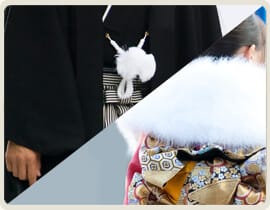 In most adult ceremonies there is no provision for clothing.
In most adult ceremonies there is no provision for clothing.However, since the ceremony is a milestone to realize that you are an adult, it is preferable to participate in dress.
Women are kimono, followed by suits, dresses and dresses. Men are most commonly dressed in dark suits and ties.
Some people participate in a samurai crested haori dress.
In modern times, it is a kimono worn only by unmarried women, but originally "Tomesode"
The kimono with long sleeves is called “furisode”, and it was a costume worn by men and women before the original clothes.
The kimono can be worn in formal situations as an unmarried woman.
It can be used for many occasions such as receptions, re-dressing, various parties, and ceremonies.
You can also reduce the length of the sleeve to make it a “visiting suit”.
Choose a pattern and color that can be worn for a long time.
► to top
What is kimono
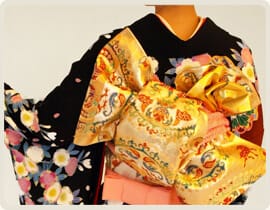 Furisode is a kimono with long sleeves and is the most prestigious kimono worn by unmarried women. The sleeve is the largest, approximately 3 scale (114cm),
Furisode is a kimono with long sleeves and is the most prestigious kimono worn by unmarried women. The sleeve is the largest, approximately 3 scale (114cm),There are also sleeves in Kurumashima. There are many gorgeous and youthful patterns, and they are worn on sunny stages such as adult ceremonies and weddings.
Depending on the length of the sleeve, it can be divided into 3 types of large kimono, medium kimono, and small kimono.
The sleeves with large sides that are characteristic of kimono have a higher body temperature than adults,
16, which is easy to generate heat by moving around, was created to keep the body temperature constant for men and women under 7.
At the time, this was called "Wakiake" and it seems that there was no shortening of sleeve length (Tomesode).
In this way, emphasis was placed on practical aspects, not on decorative intentions.
However, with the passage of time, emphasis was placed on the decorative side rather than the practical side.
Began to have a unique aspect such as being used. In the late Edo period, kimono was established as worn by children and unmarried women.
It was in the middle of the Edo period that kimonos spread as fine clothes.
It is said that the long sleeves were attached from the swaying motion. In addition, there is another meaning of the long-sleeved kimono that “long sleeves shake off trouble”.
In particular, 19 is a bad year for women. To protect yourself from various disasters and illnesses,
It was a long-standing practice to wear a kimono with a kimono in a bad year of 19, and this habit was handed over to the present adult ceremony.
► to top
Adult gifts
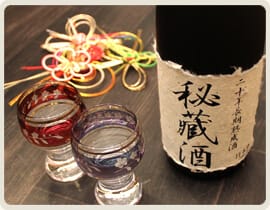 For ceremonial relationships, adult celebrations are not required.
For ceremonial relationships, adult celebrations are not required.The adult celebration is a celebration of the relatives, so it is basic to celebrate with parents and grandparents.
Generally, the gift is given until the day before the ceremony or in the morning.
You can also give a gift saying "It's an adult celebration" on your 20 birthday.
The approximate amount of money is between 5 1,000 yen and 1 10,000 yen for relatives, and about 3 1,000 yen for acquaintances.
It would be better to use a red-and-white bow and a table with "Adults", "Adults" and "Celebrations".
As gifts, things such as suits, ties, watches, accessories, bags, etc. are generally useful after becoming a member of society, but cash may also be given if you are close relatives.
In general, there ’s no need to give back to the adult-style celebration,
Please send a thank you note. Of course, after getting a celebration, it is good manners to be issued immediately.
And, of course, thank you letter of appreciation, and the person who celebrates it will do it by hand.
If you are not from relatives or relatives, it is common to return 1 / 3 from the amount you received.
► to top
